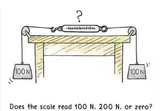>>16743192
>And you are going to draw a false equivalence between this cube and the one that just went through the blue portal.
The equivalence is not false. A portal is:
Just.
A.
Hole.
There is an absolute equivalence between the two cubes until the moment one cube experiences a force that the other does not.
>If the mass of the pedestal is negligible compared to the cube
I'll just stop you there. We can assume the cube's mass is a rounding error from zero because the cube's mass does not factor in to whether it launches.
>If the mass of the cube is negligible compared to the pedestal, it will be swept up by it, and the relative motion between piston and pedestal is unchanged. The cube enters the portal at a speed of 2x, and exits the blue portal at 2x.
>Any other combination of relative mass will result in a speed between x and 2x on the blue side. Curiously, it seems your A scenario would actually result in the greater speed for the cube.
I'll just take the cat out of the bag and tell you what matters is the relative mass of the pedestal and the piston. The cube's mass is irrelevant. The cube "launches" at the *difference* of the two forces upon impact, not the sum. You adding the forces like this is not much different from the error people make interpreting pic related.
>>16743194
>the pedestal will have hit the other cube in both cases as well, because they were due to meet in the middle. So the fact that it is still stationary relative to the observer in your scenario B suggests that the pedestal (in this case) has negligible mass indeed, which is confirmed by it being swept aside by the piston.
I was hoping you were intelligent enough to know to disregard obvious pedantry like this. Reinterpret the image but as if the second cube started offset by exactly one half the width of the first cube.
